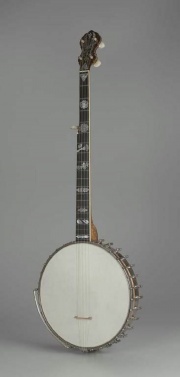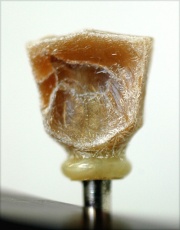Difference between revisions of "Celluloid"
(username removed) |
(username removed) |
||
| Line 2: | Line 2: | ||
== Description == | == Description == | ||
| − | Celluloid was originally a trademark [Hoechst Celanese] and is now a generic term for [http://cameo.mfa.org/materials/fullrecord.asp?name=cellulose | + | Celluloid was originally a trademark [Hoechst Celanese] and is now a generic term for [http://cameo.mfa.org/materials/fullrecord.asp?name=cellulose%20nitrate cellulose nitrate] plasticized with [http://cameo.mfa.org/materials/fullrecord.asp?name=camphor camphor]. Celluloid was commercially produced in 1872 by John and Isaiah Hyatt after they patented the material in the U.S. in 1870 (#105,338). Celluloid was marketed as a substitute for [http://cameo.mfa.org/materials/fullrecord.asp?name=ivory ivory], [http://cameo.mfa.org/materials/fullrecord.asp?name=horn horn], [http://cameo.mfa.org/materials/fullrecord.asp?name=amber amber], [http://cameo.mfa.org/materials/fullrecord.asp?name=tortoiseshell tortoiseshell] for use in piano keys, dolls, buttons, combs, brushes, mirrors, collars, dental plates, and other small items. The tough, transparent sheets and strips of celluloid were also used for photographic and motion picture films as well as animation cels. Celluloid film was cast from a solution of cellulose nitrate with wood alcohol ([http://cameo.mfa.org/materials/fullrecord.asp?name=methyl%20alcohol methanol]), amyl nitrate, camphor and fusel oil ([http://cameo.mfa.org/materials/fullrecord.asp?name=amyl%20alcohol%2C%20mixed%20isomers amyl alcohol]). |
Note: Cellulose nitrate plasticized with camphor was patented in 1855 in England by Alexander Parkes and sold as [http://cameo.mfa.org/materials/fullrecord.asp?name=Parkesine Parkesine] and later as Xylonite. | Note: Cellulose nitrate plasticized with camphor was patented in 1855 in England by Alexander Parkes and sold as [http://cameo.mfa.org/materials/fullrecord.asp?name=Parkesine Parkesine] and later as Xylonite. | ||
| Line 36: | Line 36: | ||
== Authority == | == Authority == | ||
| − | * | + | * R. J. Gettens, G.L. Stout, ''Painting Materials, A Short Encyclopaedia'', Dover Publications, New York, 1966 |
| − | * | + | * G.S.Brady, ''Materials Handbook'', McGraw-Hill Book Co., New York, 1971 Comment: p. 172 |
| − | * | + | * Ralph Mayer, ''A Dictionary of Art Terms and Techniques'', Harper and Row Publishers, New York, 1969 (also 1945 printing) |
| − | * | + | * Richard S. Lewis, ''Hawley's Condensed Chemical Dictionary'', Van Nostrand Reinhold, New York, 10th ed., 1993 |
| − | * | + | * C.V.Horie, ''Materials for Conservation'', Butterworth-Heineman, London, 1997 |
| − | * | + | * Website address 1 Comment: History of Plastics: www.nswpmith.com.au/historyofplastics.html |
* ''The Dictionary of Art'', Grove's Dictionaries Inc., New York, 1996 Comment: E.McParland "Ivory" "Plastic" | * ''The Dictionary of Art'', Grove's Dictionaries Inc., New York, 1996 Comment: E.McParland "Ivory" "Plastic" | ||
| Line 52: | Line 52: | ||
* Wikipedia, the free encyclopedia, at http://www.wikipedia.com Comment: http://en.wikipedia.org/wiki/Celluloid (Accessed Jan. 15, 2006) | * Wikipedia, the free encyclopedia, at http://www.wikipedia.com Comment: http://en.wikipedia.org/wiki/Celluloid (Accessed Jan. 15, 2006) | ||
| − | * | + | * Random House, ''Webster's Encyclopedic Unabridged Dictionary of the English Language'', Grammercy Book, New York, 1997 |
* ''The American Heritage Dictionary'' or ''Encarta'', via Microsoft Bookshelf 98, Microsoft Corp., 1998 | * ''The American Heritage Dictionary'' or ''Encarta'', via Microsoft Bookshelf 98, Microsoft Corp., 1998 | ||
| Line 58: | Line 58: | ||
* ''CRC Handbook of Chemistry and Physics'', Robert Weast (ed.), CRC Press, Boca Raton, Florida, v. 61, 1980 Comment: density=1.4 | * ''CRC Handbook of Chemistry and Physics'', Robert Weast (ed.), CRC Press, Boca Raton, Florida, v. 61, 1980 Comment: density=1.4 | ||
| − | * | + | * George Savage, ''Art and Antique Restorer's Handbook'', Rockliff Publishing Corp, London, 1954 |
[[Category:Materials database]] | [[Category:Materials database]] | ||
Revision as of 06:52, 24 July 2013
Description
Celluloid was originally a trademark [Hoechst Celanese] and is now a generic term for cellulose nitrate plasticized with camphor. Celluloid was commercially produced in 1872 by John and Isaiah Hyatt after they patented the material in the U.S. in 1870 (#105,338). Celluloid was marketed as a substitute for ivory, horn, amber, tortoiseshell for use in piano keys, dolls, buttons, combs, brushes, mirrors, collars, dental plates, and other small items. The tough, transparent sheets and strips of celluloid were also used for photographic and motion picture films as well as animation cels. Celluloid film was cast from a solution of cellulose nitrate with wood alcohol (methanol), amyl nitrate, camphor and fusel oil (amyl alcohol).
Note: Cellulose nitrate plasticized with camphor was patented in 1855 in England by Alexander Parkes and sold as Parkesine and later as Xylonite.
Synonyms and Related Terms
pyroxylin; cellulose nitrate; nitrocellulose; Cellonite; Pyralin; Ivornine;
Ivorite; Xylonite; Ivoride; Zelluloid (Deut.); celluloide (It.); celuloid (Pol.); celluloid (Sven.); celuloide (Esp.); nitrato de celulosa (Esp.); nitrocelulosa (Esp.)
Other Properties
Burns with a bright, violent flame; smells of nitrogen oxides. Soluble in acetone, amyl acetate, ethanol. Insoluble in water.
| CAS | 8050-88-2 |
|---|---|
| Density | 1.34-1.40 |
Hazards and Safety
Flammable.
Additional Information
J.Reilly, "Celluloid Objects: Their Chemistry and Preservation" JAIC, 145-162, 1991. Link
Authority
- R. J. Gettens, G.L. Stout, Painting Materials, A Short Encyclopaedia, Dover Publications, New York, 1966
- G.S.Brady, Materials Handbook, McGraw-Hill Book Co., New York, 1971 Comment: p. 172
- Ralph Mayer, A Dictionary of Art Terms and Techniques, Harper and Row Publishers, New York, 1969 (also 1945 printing)
- Richard S. Lewis, Hawley's Condensed Chemical Dictionary, Van Nostrand Reinhold, New York, 10th ed., 1993
- C.V.Horie, Materials for Conservation, Butterworth-Heineman, London, 1997
- Website address 1 Comment: History of Plastics: www.nswpmith.com.au/historyofplastics.html
- The Dictionary of Art, Grove's Dictionaries Inc., New York, 1996 Comment: E.McParland "Ivory" "Plastic"
- Wikipedia, the free encyclopedia, at http://www.wikipedia.com Comment: http://en.wikipedia.org/wiki/Celluloid (Accessed Jan. 15, 2006)
- Random House, Webster's Encyclopedic Unabridged Dictionary of the English Language, Grammercy Book, New York, 1997
- The American Heritage Dictionary or Encarta, via Microsoft Bookshelf 98, Microsoft Corp., 1998
- CRC Handbook of Chemistry and Physics, Robert Weast (ed.), CRC Press, Boca Raton, Florida, v. 61, 1980 Comment: density=1.4
- George Savage, Art and Antique Restorer's Handbook, Rockliff Publishing Corp, London, 1954

